An Insight into Jon Coleman: Part 3
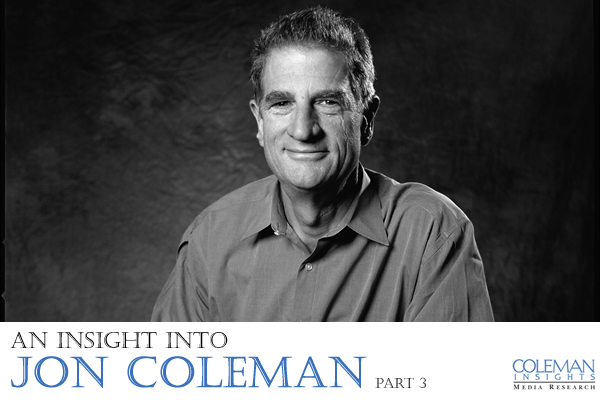
In part 3 of An Insight into Jon Coleman, Greg Smith asks Jon what advice he has for PDs or Content Directors on how to get the best out of on-air talent. And what are some of the key ingredients that programmers should keep in mind for making great radio.
Greg Smith: You’re now working in many countries around the world. What are some of the cultural differences you had to adjust to in a country like India?
Jon Coleman: In reality it has been easier to adjust to different cultures than one might think. I know when we went into India we were very cautious about assuming anything. This was India after all. It was nothing like the U.S., England, Australia or Western Europe.
But what we found is that in some very important ways it’s the same. It’s the same because people are people and while they may use different languages to communicate and their cultures may be different, all humans do process information in the same ways. So, most or all of the “rules” of communication exist in India. Ideas like “one message at a time”, or that “pre-learned concepts can interfere with new concepts”, and things like that are universal communication principles.
Where India is different is in the paradigm of programmers and managers on what makes good radio. This is where countries are different. In many countries there are built in beliefs or assumptions about the role of news, DJ’s, contests, the giving of the time on radio etc. Sometimes the ideas are in sync with listeners and sometimes they are not. Occasionally, it is difficult for some programmers and managers to see beyond the industry paradigm in which they were nurtured and currently live in and adjust to the real desires and needs of the audience.
GS: What are some of the key ingredients that programmers should keep in mind for making great radio?
JC: I think the ingredients in good radio live in two domains. One is the emotional and the other the rational. Most research lives in the rational domain. Research is often focused on the structural components of a station. Where does the station stand on dimensions like music, personality images, contests, etc. Using research, radio stations sometimes focus on the right dimension, but do it in a way that is too sterile or lacks show biz creativity. This is where old school programmers like Bill Tanner may have a leg up on some of the newer PD’s. The old school programmers focused on the show business part of a radio station, occasionally doing things that sounded cool to them, but which the audience did not really understand or to which they did not respond behaviorally. The audience might not respond because the show biz got in the way of a clearly communicated message or a contest was too hard to win, so no one played.
Some programmers like Tanner adapted to the era of radio research, marketing principles and positioning. And, some of the new school programmers have been able to develop skills for developing an emotional bond with the audience. But, to be really successful you need to address both.
 GS: What advice can you give PDs or Content Directors on how to get the best out of their on-air talent?
GS: What advice can you give PDs or Content Directors on how to get the best out of their on-air talent?
JC: This is a tough question. I did not know that you were going to call upon my skills as a personal counsellor. Seriously, though, I have learned some things by watching successful PD’s interact with their morning shows and with talent in other dayparts.
The first thing I would say is do a lot of training before a jock even goes on the air. Get across to the talent the goals of the station, the important “busy work” of station and deeply imbue them in the brand values of the station. These are things that can only be taught at the beginning. If not taught at the beginning, changing talent behaviour later on gets harder. There can always be fine tuning, but if a talent does not understand the brand or the things that are important to communicate they will easily get off course and getting them back on course can be very hard.
Then, meet with them regularly to review their performance. Make it a regular meeting, not one that occurs only when they have done something wrong. The meeting cannot have only negative consequences for the talent. In fact, make a majority of your meetings a win for the talent. If it’s always a loss, they will dread it and will ignore your suggestions.
Don’t ever manage the talent over the phone or via a text message. With the exception of an emergency, this has a negative consequence.
One other thing I have learned is that if you have a heritage show that has been very successful for a number of years and is now getting a little old or stale, you need to be very careful trying to change the show. Older shows that have been doing something the same way for a lot of years are not going to change much if at all. The harder you get in there and try to change things the more likely your efforts will backfire.
The talent may not think rationally or respond the way you think they should. In that event, they act as if would rather give up a hefty salary than change their way of doing things. And that is usually what happens, they end up giving up their salary to protect their pride. So, I tell management not to “stir the pot” if they are unprepared for the consequences.
GS: What do you believe are the best three radio programs you’ve listened to this year & what do they have that others don’t?
JC: That is hard. The first one that comes to mind is Brooke and Jubal on Movin’ 92.5 in Seattle. It has tremendous structure that serves as anchors or fence posts for listeners, but it also has tremendous personalities who exploit the formal structure to let their personalities shine. This makes a very tight and compelling show. This show has a lot of structure that makes it easy for listeners to consume.
 I think the hit podcast “Serial” is also very compelling. The first episode of this show is basically a “cold case” investigative report done in audio only and is done by the producers of “This American Life” (an American public radio show) and distributed via podcast. It is not broadcast. This long form audio show is serialized over a number of episodes. What it has that virtually all broadcast radio lacks is compelling “real” story telling. The show “This American Life” is a weekly story telling show, but the stories are not serialized over weeks like the show Serial. Once you listen to one episode, you can’t stop listening. American radio has little room for long form like this because that is not how people use over the air radio. My hunch is that Serial is consumed more like old time radio shows in the 30s and 40s.
I think the hit podcast “Serial” is also very compelling. The first episode of this show is basically a “cold case” investigative report done in audio only and is done by the producers of “This American Life” (an American public radio show) and distributed via podcast. It is not broadcast. This long form audio show is serialized over a number of episodes. What it has that virtually all broadcast radio lacks is compelling “real” story telling. The show “This American Life” is a weekly story telling show, but the stories are not serialized over weeks like the show Serial. Once you listen to one episode, you can’t stop listening. American radio has little room for long form like this because that is not how people use over the air radio. My hunch is that Serial is consumed more like old time radio shows in the 30s and 40s.
A third show would be Mike and Mike on ESPN. Mike and Mike are two guys who talk sports, one from the perspective of the average fan and the other as a former player. They play these roles well and the plot of the show clearly involves their two points of view. They use these roles to create comedic and dramatic tension. So, on that level I think it is really good.
It is also good given the challenges it faces as a national show. In the United States, like many countries, sports is a passion, but almost all sports is really local. People root for their local teams and beyond that the casual fan has little interest.
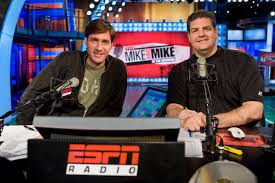
Mike and Mike are a national show that generally deals with the big national sports story or event of the day. Recognizing that sports is local, this is a challenge since in virtually every market there is a good local show that focuses on more important content, content about their local team. Many of these shows beat Mike and Mike in the ratings, but Mike and Mike do very well given their national perspective.
I think Mike and Mike is an excellent show because of how they play their relationship and how they cover national stories. They always seem to find an interesting angle in stories that on the face of them might not appeal to people who are more interested in the recent success or failure of their local team. Finding the angle that everyone can find interesting is very hard to do. The show is also well planned and produced.
GS: The Coleman Image Pyramid has been used by many radio stations all over the world. I see that Jacobs Media has come up with their own version. What importance do your clients place on The Image Pyramid in their strategic planning?
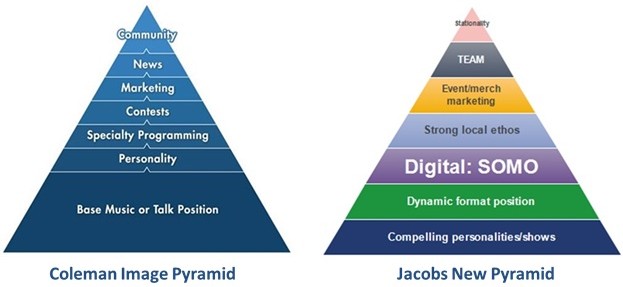
JC: I don’t want to overstate it, but I would say that most clients place a great deal of importance on it. I know that Guy Zapoleon, one of the lead programmers for iHeart radio, reminds his programmers about it all the time. It is the basis for how we at Coleman Insights think about our research and radio in general. Jacobs has suggested that personality needs to be at the base of our Image Pyramid instead of music. Although we do not diminish the immediate or long range importance of personality (not one iota), we don’t think the time has come to yet relegate music to an inferior position. The bottom line is that music is still the main reason most people listen to radio on non news/talk stations. You can read more about this discussion between Jacobs and Coleman at our blog which is linked above.
GS: You’ve published many free research projects on your website. Which one has received the most attention from programmers?
JC: I think there is little doubt that the study we called “What Happens When the Spots Come On?” is the study that had the biggest impact. It has had the biggest impact because every sector of the radio business (owners, GM’s, PD’s, sales people, sales managers, advertisers, investors and outside press) have been and are still interested. The study measured the size of the audience during commercial breaks. Much to everyone’s surprise radio’s net audience during commercials was 92% of what it was during the previous minute in non commercial content.
The study has been misunderstood or misinterpreted, so it deserves a brief explanation here. Some thought the study said that a radio station retained 92% of its audience during commercial breaks, but that is not what it said. It said the audience has 92% of the audience it has moments earlier when playing a song or doing other content.
We found that there is always more than 8 percentage points of audience that tune out of the commercials, but what we also found is that much of the loss is compensated for by “tune in” during the commercials. In the minds of most of us radio people, commercials always meant just audience loss. We did not think about the fact that during commercials some people would tune-in to a station and stick during the commercial break.
So, for example if 15% tune out and 7% tune in, the net audience is 92% of the original audience. If 25% tune out and 17% tune in, the net audience is also 92%.
This study was replicated three times and by two different companies and the result was the same each time. So, we know it is true. It is an absolutely fantastic story about the ability of radio to deliver a significant audience and deliver those numbers through a six or seven minute break.
The study is also a strong testimony to advertisers that they get what they pay for when they buy audience based on Nielsen PPM data. I should also add, that this net audience level is greater for radio than TV. TV stations net audience levels are lower in commercial breaks than for radio.
GS: What kind of challenges and opportunities do you see for radio in this world of social media?
JC: I think there are challenges at several levels. Let me address a couple. First, I think we are at a very basic level of knowing how to use social and digital in general. It is obvious that radio needs to use social media to have a conversation with consumers. But, the first question is “what is the conversation about?” In other words what is the content of our conversation? What do listeners want the conversation to be about? How do we measure relevance? Does consumer response equate to relevance? For example, in a study we did recently for a large Rock radio brand, we found that there was not necessarily a correlation between the posts or tweets that drew the greatest reaction and consumer relevance. Often a contest or a giveaway generate a lot of response, but the mass audience can find those to be noise that actually drive them away from a station rather than adding to the radio experience or enhancing the brand.
Another challenge is learning how to use social and digital as an advertising medium. A lot of radio stations are using paid social and digital as their sole or main medium for communicating an advertising message with the audience. They have eschewed outdoor, transit or TV for social and digital under the belief that they can reach everyone there and for less cost. We have not yet seen a social or digital campaign generate the same impact that one gets in traditional media. I think this is the same result some national advertisers are experiencing with social. Many of these big companies are returning to traditional media, including radio, because they are not getting the bang for their buck in social only. This does not undermine using digital media for advertising, but it does say we may need to go back to traditional media as the base for important media campaigns.
The opportunity for radio is to understand both how to talk with consumers via social and to learn how and when to use social and digital as an advertising medium.

GS: And how has social media changed the way you do business?
JC: It has not dramatically changed the way we do business because our main goal is to understand the behaviour and attitudes of audiences. That said, we now measure social media usage, recall of radio station social efforts, etc. It is all a part of our effort to help radio attract a larger audience.
We also look at social media as another voice for radio so we examine what people want and expect from radio via social as I described a moment ago.
Social has also had some impact on how we conduct our research. Ten years ago we did most of our attitude research over the phone. If we wanted a representative sample of the audience a phone sample was best.
But, over the last ten years or so, that has changed and is no longer the case. So, now we recruit and interview a large percentage of our sample via digital and social. How we do that exactly is too complicated to outline here, but we now draw representative local and national samples from a combination of telephone and digital media and we interview consumers using both these methods and a few others as well.
GS: There are many career highlights. Is there a stand out moment that you really cherish?
JC: To pick a single moment or event is difficult of course. I cherish the relationships I have developed in and outside the company more than anything. Lifelong friendships with clients and co-workers.
I also cherish every single successful radio launch of one of our client’s stations. Fortunately, there have been a lot, like the big launches early in my career of Mix 106.7 in Baltimore or Lite in Houston (where we began the national use of these radio monikers) or the repositioning of Power 106 in Los Angeles in 1991, which included the commercial and radio discovery of Hip Hop music by Coleman’s Pierre Bouvard. What a story! To think that our company helped launch Hip Hop as a mainstream cultural phenomenon is bone chilling.
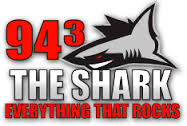 In the few ten years we also have participated in a number of successful launches of CHR, Rhythmic, Country and Rock stations like The Shark on Long Island in New York, or a small market launch of the Country station The Blaze in Chico, Ca.
In the few ten years we also have participated in a number of successful launches of CHR, Rhythmic, Country and Rock stations like The Shark on Long Island in New York, or a small market launch of the Country station The Blaze in Chico, Ca.
We have also played an important role in developing the only successful female talk station in the United States, My Talk 107 in Minneapolis. All of these make me feel very proud and I cherish them all.
But, of all of the moments I cherish, the most exciting moment ever was in Phoenix in the mid 1980s. KZZP had just relaunched as “The Number One Hit Music Station”. I mentioned this earlier.
We were doing follow-up focus groups to test the health of the station and gauge the success of the relaunch. I walked into the interview room with ten respondents quietly sitting, not quite sure what was going to happen. I introduced myself and said I wanted to talk about radio. With not one more word of prompting the ten listeners in unison began reciting the KZZP Phrase That Pays, a phrase that Coleman Insights penned and that KZZP executed masterfully. The phrase was much more than a radio promotion, it had become a social meme. Together we had impacted a million people and made them smile. In that one moment chills went through my body and I knew it was going to be a good night.
GS: What are the two most important books that have affected the way you think?
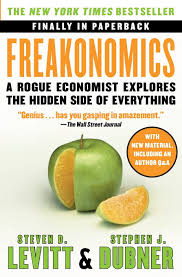 JC: Reis and Trout remain the most important authors ever. Their book Focus is the best of all their books. It powerfully summarizes how to communicate with consumers. Anyone in our business who has not read it, should!
JC: Reis and Trout remain the most important authors ever. Their book Focus is the best of all their books. It powerfully summarizes how to communicate with consumers. Anyone in our business who has not read it, should!
I also like Freakonomics by Leavitt and Dubner. It is a fun book, but it is also a book that teaches that many beliefs can be tested. I think there are too many “givens” in radio that are accepted without testing. This book examines a lot of “givens” in the social sphere and finds them wanting when they are tested empirically. It has taught me that it is right to question and put supposed truths to the test of logic and investigation. The book is also very fun to read. These guys look at the weirdest things with an eye towards testing them with real data.
GS: What do you do for fun?
JC: Answer Greg Smith’s questions! Seriously, I did enjoy answering them because you forced me to talk in one interview about a lot of the things that have been important in my professional life. You have got me talking about what drives me, how that influenced the company, the things that we have innovated, what we have learned and the challenges ahead. So, I thank you for that.
But, in my spare time there are a few things I really enjoy. One of the main things I do for fun is study Spanish. I have been studying Spanish for seven years. It is impossibly hard, but “poco a poco” I have become conversant in Spanish. Once a week for seven years I have gotten on Skype and talked to my teacher in Lima, Peru. Sometimes my wife Linda looks at me reading in Spanish or watching Univision’s “Primer Impacto” and she thinks I am crazy, but believe it or not, I find it fun and relaxing.
I also love watching or going to sports with my son Peter and rooting for baseball’s World Champion San Francisco Giants with my wife Linda. I love baseball season.
You can read Part 1 here and Part 2 here.


